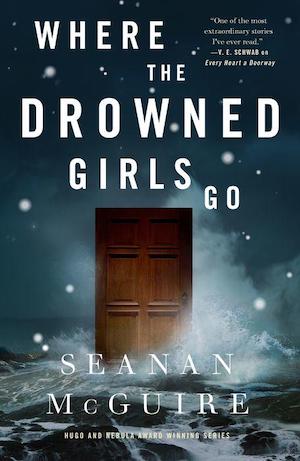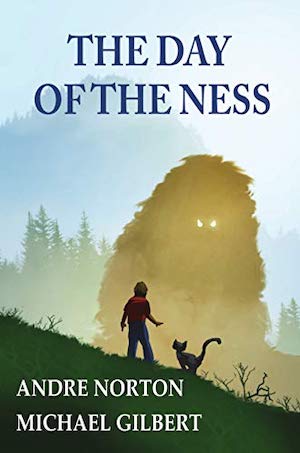This is a nice little a palate cleanser after a series of long and intricate adult novels. It’s short and concise, tightly plotted and narrowly focused, but in a good way. As middle-grade books go, it’s solid.
What’s interesting about it is that the co-author, Michael Gilbert, was (is?) an artist. The illustrations are his. Mostly they’re fairly timeless, though young Hal’s father has a classic Seventies mustache, which is appropriate enough for a book published in 1975. There’s no way he could have known that 2021 would call it a “porn ’stache” and see a distinct resemblance to Freddie Mercury.
The story is set sometime after 1975. Lasers are a fully developed form of weaponry, and there are flying cars. Flying cars were The Future in 1975. Instead we have supercomputers in our pockets. I suppose it’s a worthy tradeoff.
The Ness of the title is not, a little disappointingly, the famous Scottish loch. It’s an evil alien, and it’s doing awful things to good little aliens, who fight back with the help of young Earth human Hal. Hal’s father is a scientist with NASA; he’s part of the Project, which has been observing a colony of shipwrecked aliens. The aliens have landed in a remote area of the U.S., and they don’t interact directly with humans. The territory they have claimed is booby-trapped, but they have been allowing humans to approach a particular spot and exchange various and somewhat random items.
This trade has been going on for years without any clear or ultimately bankable insight into the aliens’ culture or even their physical appearance. Recently the trade has stopped, and no one has managed to either get it started again or to find out anything about the aliens. As a result, the Project has been cut back and is on the verge of being closed down. Only Hal’s father and a couple of other people are still involved, and when the story begins, Hal’s dad has gone away on business.
Hal is a free-range kid, a strange and indeed alien concept in 2021. He’s solitary but not lonely. He has a companion, a very intelligent and interactive cat named Susie. Hal and Susie have been exploring the alien landing site, where they’re not really supposed to be, but they’re both insatiably curious.
That curiosity does not kill the cat—which may be a spoiler, but if you’re like me, you’re always glad to know that the cat (or dog or horse) doesn’t die. Instead, Hal and Susie find their way into the aliens’ hidden tunnels, where they’re enlisted to save them from enslavement by the horrible Ness. In order to do this, Hal has to rescue their leader, the Great Think-Think, and use his independent human brain to put together a plan and defeat the Ness.
Buy the Book


Where the Drowned Girls Go
The aliens are very small and very shy. They’re afraid of big humans, who in fact are too big to enter the tunnels, but Hal is small and his friend Susie is even smaller. He’s also less aggressive and more inclined to cooperate with an alien species. He won’t be blowing them up on general principle.
The aliens are a kind of hive creature with different functions that manifest in distinct forms. These are quite strange but rather charming, with little spindly fingers and expressive antennae. The Stalkers look like Jawas (shortly before Star Wars burst upon the world). The Great Think-Think and his (they are all male, or so Hal thinks) mini-Think-Think are ambulatory, telepathic televisions. They are weird and very cute.
Only the Think-Thinks are capable of planning and making decisions, but the others can communicate and execute. Hal takes over as a sort of Think-Think, not entirely willingly, but the need is great and the aliens are desperate. He leads them against the Ness, who look like Jabba the Hutt—again, before Star Wars was an actual thing.
Makes me wonder, it does. Though Norton nearly always associated evil with ugliness, and her villains were often fat, blobby, and completely without redeeming features. Jabba the Ness is a more or less standard style of Norton evil alien.
I have no way of knowing which author contributed which elements, but the plot and characters in general are mainline Norton. The solo kid, the cat companion, the underground adventure, the strict dualism of plot and characters; the secret Project, the unremitting maleness of the universe except for the cat—Hal has no mother and appears never to have had one—and the no-contact trading method: putting objects in a specific spot and coming back to find out which ones were taken and what was put in their place.
If I were to guess, I would say much of the plot and setting are Norton, but the aliens and the general setup are probably Gilbert. The good-guy aliens are so unusual; there’s a vivid visual imagination there. As much as Norton did love to create strange beings and nasty monsters, there’s a slightly different flavor to these.
It’s just a guess, of course, and that’s a good thing in itself. The collaboration is another one that works. It reads smoothly, it feels seamless. It’s nice and compact, with great pacing. It’s an enjoyable little book.
I’ll be taking a bit of a break in the Reread; the next installment will post in January. I tackle another collaboration and a new-to-me collaborator in Beast Master’s Circus. In the meantime, happy holidays, and happy reading!
Judith Tarr has written historicals and historical fantasies and epic fantasies and space operas, many of which have been published as ebooks. She has won the Crawford Award, and been a finalist for the World Fantasy Award and the Locus Award. She lives in Arizona with an assortment of cats, a blue-eyed dog, and a herd of Lipizzan horses.











I always appreciate a heads up if an animal is killed. Sad being that I am, that upsets me more than any human death except a child’s. Jabba looks fuzzy which is an interesting look.
putting objects in a specific spot and coming back to find out which ones were taken and what was put in their place.
I think the crew of the Solar Queen used similar methods of trading with the Salariki.
Happy Holidays!
I have to know if the animal(s) survived too, to the extent that if I can’t find out I won’t read the book.
I’m 54 and still have my $1.25 Dell Yearling copy of The Day of The Ness. I haved loved the illustrations, and both they and the story have informed my own art and sense of good science fiction.